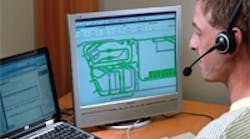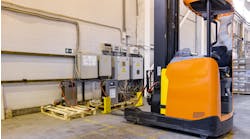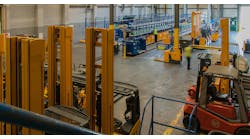When it comes to material handling equipment, the days of compromise are gone. As capital expenditures and access to credit dry up, squeezing every bit of life out of equipment becomes a survival strategy, not just a way to reduce repair costs.
For professionals overseeing high-throughput manufacturing facilities, strict equipment maintenance procedures are long-time staples. In fact, these plants often employ dedicated maintenance, repair and operations engineers. Equipment that facilitates the process of production has long been viewed as a mission-critical asset, vital to the health of the overall business.
Most material handling professionals think of maintenance in terms of preventive maintenance (PM), which encompasses regularly occurring procedures that preserve the life of equipment. Preventive maintenance is usually preplanned to coincide with a scheduled equipment shutdown.
However, there’s another type of maintenance that is far removed from wrench turning or parts lubrication. For advanced, high-throughput manufacturers, maintenance is a continuous process, driven by massive amounts of information and some of the most advanced monitoring technologies available. This approach is called predictive maintenance (PDM), and thanks to recent offerings from equipment suppliers, distribution professionals are getting in on the action.
Condition Monitoring
“We see PDM as an extension, an enhancement, to a preventive strategy,” says Phil Gilkes, director of service engineering, North America, at St. Louis-based FKI Logistex. “The predictive approach is based on monitoring the condition of the equipment and then, based on that data, carrying out preventive strategies to prevent failure.”
As suppliers recognize the value that advanced maintenance brings to their cash-strapped clients, they are increasingly offering software tools and technical services for condition monitoring and analysis—the essence of PDM.
“Mitigating risk is very important right now,” says Chris Roach, vice president of customer service and support at FKI Logistex. “The trend in the U.S. over the last 10 to 15 years has been to maintain exceptionally lean inventory in distribution centers. As you lean out, downtime becomes less acceptable, and that makes proactive maintenance more valuable.”
The opposite of proactive maintenance is reactive maintenance, which happens after equipment breaks. As most material handling professionals know, unscheduled downtime is far more costly than the repair itself. PM can prevent disastrous breakdowns, but it must be scheduled during off-peak times.
PDM goes further—it predicts when equipment will fail, therefore allowing plant supervisors to plan and schedule PM ahead of time. PDM is based on the assumption that equipment is operating properly when measurements of vibration, heat, pressure, tension, alignment and other conditions fall within a certain range. As equipment wears, these variables change, signaling the need for PM to bring measurements back into range. And, that strategy helps avoid the need for devastating downtime and emergency repairs. PM can be
prescheduled to occur during slow periods when uptime is less crucial.
“We are seeing condition monitoring becoming more prevalent,” says Gilkes. “Customers are monitoring temperature with infrared technology. As components age, differences in temperature emerge, and customers can act on that before the component ultimately fails.”
Technicians employed by FKI Logistex use devices in the field to measure operating temperature. And, the company’s new NetLok remote access system—unveiled in January at ProMat 2009—allows the company’s technical support staff to monitor the condition of a facility’s material handling equipment remotely, through a secure information infrastructure. Technicians log in to NetLok and then troubleshoot, identify and respond to potential maintenance issues.
Roach says mission-critical equipment, such as sortation systems, are well suited for PDM. “Oftentimes, when sortation equipment is down, the facility is down,” he says.
The Data Divide
The biggest barrier to setting up a PDM program is the need to access the data necessary to make it work, according to Jim Wenninger, chief executive officer of WennSoft, a New Berlin, Wis.-based provider of business management software. “Tremendous information gathering is required,” he says. That’s why PDM is usually reserved for mission-critical equipment.
WennSoft offers software modules that collect and log data essential for establishing and monitoring trends. The technology logs meter readings several times per day or week using unique date and time stamps. This data can then be analyzed to identify changes in component condition that may signal impending failure.
Despite the high-tech nature of PDM activities, Wenninger says the concept doesn’t necessarily require the use of expensive software. In theory, he says, a manager can log the operating temperature of a new motor, for example, and then measure the temperature repeatedly at specified time intervals, checking for red-flag variances.
“It can be done with simple reporting and trending,” he says. “That’s low-tech PDM.”



